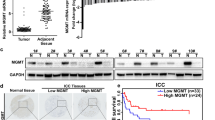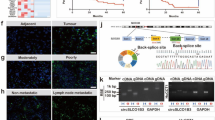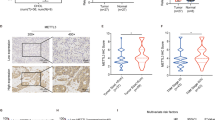Abstract
The loss of 5-hydroxymethylcytosine (5-hmC) has been identified as an epigenetic hallmark in several malignancies. However, its role in intrahepatic cholangiocarcinoma (ICC) is still unknown. Our study aims to investigate the level of 5-hmC in diagnosis and prognosis prediction of ICC. The 5-hmC levels were detected using dot blot, tissue microarray technique and immunohistochemical method, and the correlation between 5-hmC level and ICC clinicopathological parameters was analysed. Compared with matched liver tissues, most of ICC tissues presented with the loss of 5-hmC. Furthermore, the subgroups of cirrhotic and poor differentiation tissues showed the lowest level of 5-hmC. We found that 5-hmC level in non-elevated ICC patients was significantly related to lymph node metastasis and TNM stage and not related to vessel invasion, sex, age, HBV, cirrhosis or degree of differentiation. ICC patients with high TNM stage (stages III and IV) and lymph node metastases had significantly lower 5-hmC level than those with low TNM stage (stages I and II) and no lymph node metastases. Further analysis showed that low 5-hmC level is significantly correlated with worse overall survival (OS) and disease-free survival (DFS). Importantly, multivariate analysis indicated that 5-hmC level, tumour diameter, lymphatic metastasis and tumour differentiation could be used as independent prognostic factors for ICC. The loss of 5-hmC is implicated in the progression of ICC. Our results can contribute to the diagnostic ability and postoperative surveillance of ICC patients.





Similar content being viewed by others
References
Hmmill CW, Wong LL. Intrahepatic cholangiocarcinoma: a malignancy of increasing importance. J Am Coll Surg. 2008;207:594–603.
Rizvi S, Gores GJ. Pathogenesis, diagnosis, and management of cholangiocarcinoma. Gastroenterology. 2013;145:1215–29.
Ercolani G, Vetrone G, Grazi GL, et al. Intrahepatic cholangiocarcinoma: primary liver resection and aggressive multimodal treatment of recurrence significantly prolong survival. Ann Surg. 2010;252:107–14.
Wang Y, Li J, Xia Y, et al. Prognostic nomogram for intrahepatic cholangiocarcinoma after partial hepatectomy. J Clin Oncol. 2013;31:1188–95.
Ong CK, Subimerb C, Pairojkul C, et al. Exome sequencing of liver fluke-associated cholangiocarcinoma. Nat Genet. 2012;44(6):690–3.
Tyson GL, El-Serag HB. Risk factors for cholangiocarcinoma. Hepatology. 2011;54:173–84.
Lian CG, Xu Y, Ceol C, et al. Loss of 5-hydroxymethylcytosine is an epigenetic hallmark of melanoma. Cell. 2012;150:1135–46.
Ito S, D'Alessio AC, Taranova OV, et al. Role of Tet proteins in 5mC to 5hmC conversion, ES-cell self-renewal and inner cell mass specification. Nature. 2010;466:1129–33.
Chowdhury R, Yeoh KK, Tian YM, et al. The oncometabolite 2-hydroxyglutarate inhibits histone lysine demethylases. EMBO Rep. 2011;12:463–9.
Xu W, Yang H, Liu Y, et al. Oncometabolite 2-hydroxyglutarate is a competitive inhibitor of α-ketoglutarate-dependent dioxygenases. Cancer Cell. 2011;19:17–30.
Dang L, Jin S, Su SM. IDH mutations in glioma and acute myeloid leukemia. Trends Mol Med. 2010;16:387–97.
Ko M, Huang Y, Jankowska AM, et al. Impaired hydroxylation of 5-methylcytosine in myeloid cancers with mutant TET2. Nature. 2010;468:839–43.
Liu WR, Tian MX, Jin L, et al. High expression of 5-hydroxymethylcytosine and isocitrate dehydrogenase 2 is associated with favorable prognosis after curative resection of hepatocellular carcinoma. J Exp Clin Cancer Res. 2014;33:32.
Yang Q, Wu K, Ji M, et al. Decreased 5-hydroxymethylcytosine (5-hmC) is an independent poor prognostic factor in gastric cancer patients. J Biomed Nanotechnol. 2013;9:1607–16.
Blechacz B, Gores GJ. Cholangiocarcinoma: advances in pathogenesis, diagnosis, and treatment. Hepatology. 2008;48:308–21.
Woo HG, Lee JH, Yoon JH, et al. Identification of a cholangiocarcinoma-like gene expression trait in hepatocellular carcinoma. Cancer Res. 2010;70:3034–41.
Wang P, Dong Q, Zhang C, et al. Mutations in isocitrate dehydrogenase 1 and 2 occur frequently in intrahepatic cholangiocarcinomas and share hypermethylation targets with glioblastomas. Oncogene. 2013;32:3091–100.
Jin SG, Jiang Y, Qiu R, et al. 5-Hydroxymethylcytosine is strongly depleted in human cancers but its levels do not correlate with IDH1 mutations. Cancer Res. 2011;71:7360–5.
Ke AW, Shi GM, Zhou J, et al. Role of overexpression of CD151and/or c-Met in predicting prognosis of hepatocellular carcinoma. Hepatology. 2009;491–503.
Li YY, Li H, Lv P, et al. Prognostic value of cirrhosis for intrahepatic cholangiocarcinoma after surgical treatment. J Gastrointest Surg. 2011;15:608–13.
Khan SA, Davidson BR, Goldin RD, et al. Guidelines for the diagnosis and treatment of cholangiocarcinoma: an update. Gut. 2012;61:1657–69.
Mavros MN, Economopoulos KP, Alexiou VG, et al. Treatment and prognosis for patients with intrahepatic cholangiocarcinoma: systematic review and meta-analysis. JAMA Surg. 2014. doi:10.1001/jamasurg.2013.5137.
Ficz G, Branco MR, Seisenberger S, et al. Dynamic regulation of 5-hydroxymethylcytosine in mouse ES cells and during differentiation. Nature. 2011;473:398–402.
Hahn MA, Qiu R, Wu X, et al. Dynamics of 5-hydroxymethylcytosine and chromatin marks in Mammalian neurogenesis. Cell Rep. 2011;3:291–300.
Pfeifer GP, Kadam S, Jin SG. 5-hydroxymethylcytosine and its potential roles in development and cancer. Epigenetics Chromatin. 2013;6:10.
Colquitt BM, Allen WE, Barnea G, et al. Alteration of genic 5-hydroxymethylcytosine patterning in olfactory neurons correlates with changes in gene expression and cell identity. Proc Natl Acad Sci U S A. 2013;110:14682–7.
López CM, Lloyd AJ, Leonard K, et al. Differential effect of three base modifications on DNA thermostability revealed by high resolution melting. Anal Chem. 2012;84(17):7336–42.
Wanunu M, Cohen-Karni D, Johnson RR, et al. Discrimination of methylcytosine from hydroxymethylcytosine in DNA molecules. J Am Chem Soc. 2011;133:486–92.
Acknowledgments
This study was supported by the National Key Sci-Tech Project (2012ZX10002011-002), the National Natural Science Foundation of China (81472840, 81172023, 81071741 and 81030038) and the Shanghai Municipal Natural Science Foundation (14ZR1405800, 11ZR1428300, 114119a5000).
Conflicts of interest
None
Author information
Authors and Affiliations
Corresponding authors
Additional information
Zhao-Ru Dong, Chi Zhang, Jia-bin Cai and Peng-Fei Zhang contributed equally to this work.
Rights and permissions
About this article
Cite this article
Dong, ZR., Zhang, C., Cai, Jb. et al. Role of 5-hydroxymethylcytosine level in diagnosis and prognosis prediction of intrahepatic cholangiocarcinoma. Tumor Biol. 36, 2763–2771 (2015). https://doi.org/10.1007/s13277-014-2900-2
Received:
Accepted:
Published:
Issue Date:
DOI: https://doi.org/10.1007/s13277-014-2900-2




